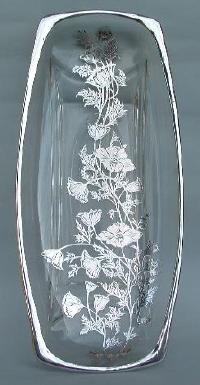National Depression Glass Association
Preserving America's Glass Manufacturing Heritage
Silver Overlay Glass
by Giorgio Busetto
Silver has been used to decorate bronze, copper, and earthenware for ages. Silver on glass, however, started to come into its own a little over a century ago.
In 1889 Oscar Pierre Erard of Birmingham, England, developed an effective method of electroplating silver on glass and porcelain. Although beautiful on the outside, it shared an important shortcoming with its predecessors. The reverse side of the silver design, the side next to the glass would tarnish and turn dark. In clear plates, bowls, dishes and glasses this unsightly result was hardly condusive to a hearty appetite.
In 1893, an American from New Jersey by the name of John H. Scharling patented a method no less simple or beautiful than Erard's creation, but with a distinct advantage. The reverse side of
 the design was snow white and it stayed that way indefinitely. Like Erard's method, Sharling's designs utilized electroplating.
the design was snow white and it stayed that way indefinitely. Like Erard's method, Sharling's designs utilized electroplating.
He shared his new process with all, both domestic and European. By 1895, the Czechs, Italians, French, English and Austrians were producing exciting glassware with sterling deposit and overlay.
Not to be outdone, US makers began producing copiously. From 1895 to the late 1920s, this elegant and exciting manifestation of the glassmaker and silversmith's art garnered its own avid following, just short of becoming a decorative rage. Silver overlay and silver deposit were regarded as an exquisite, special gift or accent for that certain table or shelf. A few nice pieces of overlay were as evident in the genteel home as a piano in those days of refined, yet simple pleasures.
The Great Depression caused many of the glass companies to either go out of business or resort to specializing in cheaper, more affordable glassware. The era of expensive sterling silver applied to glass was all but over and not many pieces can be found that were manufactured after the mid-1930s.
All overlay glasses have a design in silver 'electroplated' into the glass using electrolytic tecnique. The techniques of depositing the silver involve painting the design onto the glass with flux containing silver mixed with turpentine, firing this design in a kiln, cooling and cleaning the glass and then immersing it in a solution of silver through which a tiny electric current was passed. The silver was then built up on the area where the design had been painted.
An alternative method involved coating the whole surface with silver, painting the design onto the silver with a 'resist' and then dissolving away the unwanted parts of the silver.
In the photo at right is a glass tray with a large floral silver overlay decoration. Its origin is unknown but possibly it was made in the USA, circa 1950. The tray is 9 1/2 in. wide (cm. 24) and it was suggested that this was the "poppy" pattern of Silver City Glass Co, Meriden, CT (a firm active since 1907).
Webmaster's NOTE: The NDGA wishes to thank the author for permission to use this article. Giorgio Busetto is from Italy, and he is a collector of Silver items -- silver overlay glass is but a small part of his collection. The description of the process involved in Silver Overlay is the best I've ever seen. His web site is www.silvercollection.it/.